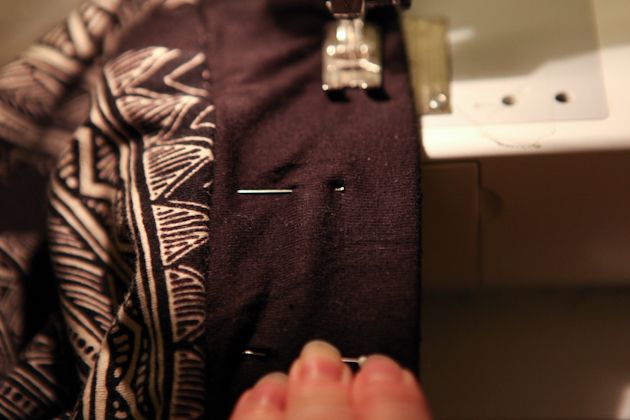11 - Fuse your 2” x 1“ scrap of interfacing to the back side of the waistband, horizontally centered behind the buttonhole marks.
 On the right side of the waistband, sew two 1/2” buttonholes on markings. Carefully open your buttonholes according to your preferred method. (I like to use two pins to protect the end points and then a seam ripper to open up the middle.)
On the right side of the waistband, sew two 1/2” buttonholes on markings. Carefully open your buttonholes according to your preferred method. (I like to use two pins to protect the end points and then a seam ripper to open up the middle.)


 On the right side of the waistband, sew two 1/2” buttonholes on markings. Carefully open your buttonholes according to your preferred method. (I like to use two pins to protect the end points and then a seam ripper to open up the middle.)
On the right side of the waistband, sew two 1/2” buttonholes on markings. Carefully open your buttonholes according to your preferred method. (I like to use two pins to protect the end points and then a seam ripper to open up the middle.)


12 - Join the two short ends of the waistband together, forming a ring, right sides together. Pin, stitch, press open.


13 - Fold the waistband in half lengthwise, wrong sides facing each other. Pin the raw edges together.
 14 - Match the right side of the waistband (side with buttonholes) to the right side of the pant at waist. Pin in place matching center backs, center fronts, and side seams to circle markings. Everything should match up really nicely, but the great thing is that even if you have a bit of extra fabric you can just stretch to fit.
14 - Match the right side of the waistband (side with buttonholes) to the right side of the pant at waist. Pin in place matching center backs, center fronts, and side seams to circle markings. Everything should match up really nicely, but the great thing is that even if you have a bit of extra fabric you can just stretch to fit.
 Stitch together leaving a 4” opening at center back.
Stitch together leaving a 4” opening at center back.
 15 - Wrap your elastic around your lower waist (not your natural waist as theses pants sit about 3" below your natural waist ) and find the length that feels comfortable, but is still snug. This is not the same as your waist measurement. Because you want it to be snug it is usually about 1" smaller than the measurement itself. Add 1/2” for overlap and cut your elastic. Attach a safety pin to one end of the elastic and feed it through the 4“ opening in the waistband until it forms a circle with both ends exiting the waistband.
15 - Wrap your elastic around your lower waist (not your natural waist as theses pants sit about 3" below your natural waist ) and find the length that feels comfortable, but is still snug. This is not the same as your waist measurement. Because you want it to be snug it is usually about 1" smaller than the measurement itself. Add 1/2” for overlap and cut your elastic. Attach a safety pin to one end of the elastic and feed it through the 4“ opening in the waistband until it forms a circle with both ends exiting the waistband.
 Overlap by 1/2” and topstitch the overlapped area of the elastic until it is secure. It is very important that this stitch is VERY secure. Stitch over it multiple times and in multiple directions. I usually stitch a rectangle and then an x inside of that.
Overlap by 1/2” and topstitch the overlapped area of the elastic until it is secure. It is very important that this stitch is VERY secure. Stitch over it multiple times and in multiple directions. I usually stitch a rectangle and then an x inside of that.
 (This might be a good time to try your pants on to check the fit of the elastic. Once you sew up the opening in the waistband it will be really annoying to adjust.)
(This might be a good time to try your pants on to check the fit of the elastic. Once you sew up the opening in the waistband it will be really annoying to adjust.)
 14 - Match the right side of the waistband (side with buttonholes) to the right side of the pant at waist. Pin in place matching center backs, center fronts, and side seams to circle markings. Everything should match up really nicely, but the great thing is that even if you have a bit of extra fabric you can just stretch to fit.
14 - Match the right side of the waistband (side with buttonholes) to the right side of the pant at waist. Pin in place matching center backs, center fronts, and side seams to circle markings. Everything should match up really nicely, but the great thing is that even if you have a bit of extra fabric you can just stretch to fit.
 Stitch together leaving a 4” opening at center back.
Stitch together leaving a 4” opening at center back.
 15 - Wrap your elastic around your lower waist (not your natural waist as theses pants sit about 3" below your natural waist ) and find the length that feels comfortable, but is still snug. This is not the same as your waist measurement. Because you want it to be snug it is usually about 1" smaller than the measurement itself. Add 1/2” for overlap and cut your elastic. Attach a safety pin to one end of the elastic and feed it through the 4“ opening in the waistband until it forms a circle with both ends exiting the waistband.
15 - Wrap your elastic around your lower waist (not your natural waist as theses pants sit about 3" below your natural waist ) and find the length that feels comfortable, but is still snug. This is not the same as your waist measurement. Because you want it to be snug it is usually about 1" smaller than the measurement itself. Add 1/2” for overlap and cut your elastic. Attach a safety pin to one end of the elastic and feed it through the 4“ opening in the waistband until it forms a circle with both ends exiting the waistband.
 Overlap by 1/2” and topstitch the overlapped area of the elastic until it is secure. It is very important that this stitch is VERY secure. Stitch over it multiple times and in multiple directions. I usually stitch a rectangle and then an x inside of that.
Overlap by 1/2” and topstitch the overlapped area of the elastic until it is secure. It is very important that this stitch is VERY secure. Stitch over it multiple times and in multiple directions. I usually stitch a rectangle and then an x inside of that.
 (This might be a good time to try your pants on to check the fit of the elastic. Once you sew up the opening in the waistband it will be really annoying to adjust.)
(This might be a good time to try your pants on to check the fit of the elastic. Once you sew up the opening in the waistband it will be really annoying to adjust.)
16 - Put the elastic all the way inside of your waistband and stitch up the 4” opening so that the elastic is fully encased and the pants are completely attached to the waistband. Press the seam allowance down towards the pant.
 Distribute the gathering on the waistband evenly. Pin waistband fabric to the elastic every few inches to keep the gathering in place. This will come in handy in the next step when you are topstitching all of those gathers. I also like to lightly iron the waistband at this time to set all of the gathers in place before stitching them.
Distribute the gathering on the waistband evenly. Pin waistband fabric to the elastic every few inches to keep the gathering in place. This will come in handy in the next step when you are topstitching all of those gathers. I also like to lightly iron the waistband at this time to set all of the gathers in place before stitching them.

 Distribute the gathering on the waistband evenly. Pin waistband fabric to the elastic every few inches to keep the gathering in place. This will come in handy in the next step when you are topstitching all of those gathers. I also like to lightly iron the waistband at this time to set all of the gathers in place before stitching them.
Distribute the gathering on the waistband evenly. Pin waistband fabric to the elastic every few inches to keep the gathering in place. This will come in handy in the next step when you are topstitching all of those gathers. I also like to lightly iron the waistband at this time to set all of the gathers in place before stitching them.

17 - Using a slight zigzag stitch (or stretch stitch) on your sewing machine, start at center back and topstitch around your waistband through both layers of fabric and the elastic at 5/8” from the top. You will need to pull your elastic until the waistband fabric is not gath- ered in front of your presserfoot as you sew. This will feel a little awkward at first, but just hang in there until you get the hang of it. I find that if I hold the waistband about 3 inches behind the presserfoot with with my left hand and about 5 inches in front of the preserfoot with the right hand that it feels most comfortable and I can hold the waistband secure without putting any tension on the sewing needle.
 Repeat with another row of topstitching, parallel to the first, at 1 1/2” from the top. (Tip : Mark this guideline with a piece of masking tape on your sewing machine.)
Repeat with another row of topstitching, parallel to the first, at 1 1/2” from the top. (Tip : Mark this guideline with a piece of masking tape on your sewing machine.)


 18 - Attach your drawstring cord to a safety pin and feed it through one buttonhole, into the casing created by the topstitching, and back out the other buttonhole. Shorten cord if necessary. There are a few ways that you can secure the ends of your cord from unraveling. You can simply stitch them, or tie a knot, or if it's synthetic you can also melt the end. I know that one of my testers just bought a shoelace to use and that way she didn't have to worry about the ends which I thought was an awesome idea.
18 - Attach your drawstring cord to a safety pin and feed it through one buttonhole, into the casing created by the topstitching, and back out the other buttonhole. Shorten cord if necessary. There are a few ways that you can secure the ends of your cord from unraveling. You can simply stitch them, or tie a knot, or if it's synthetic you can also melt the end. I know that one of my testers just bought a shoelace to use and that way she didn't have to worry about the ends which I thought was an awesome idea.

 OK, that's it for today. We are so close to being done. Just the cuffs tomorrow.
* The fabric and prizes for this sewalong were generously donated by Wanderlust Fabrics.
OK, that's it for today. We are so close to being done. Just the cuffs tomorrow.
* The fabric and prizes for this sewalong were generously donated by Wanderlust Fabrics.
 Repeat with another row of topstitching, parallel to the first, at 1 1/2” from the top. (Tip : Mark this guideline with a piece of masking tape on your sewing machine.)
Repeat with another row of topstitching, parallel to the first, at 1 1/2” from the top. (Tip : Mark this guideline with a piece of masking tape on your sewing machine.)


 18 - Attach your drawstring cord to a safety pin and feed it through one buttonhole, into the casing created by the topstitching, and back out the other buttonhole. Shorten cord if necessary. There are a few ways that you can secure the ends of your cord from unraveling. You can simply stitch them, or tie a knot, or if it's synthetic you can also melt the end. I know that one of my testers just bought a shoelace to use and that way she didn't have to worry about the ends which I thought was an awesome idea.
18 - Attach your drawstring cord to a safety pin and feed it through one buttonhole, into the casing created by the topstitching, and back out the other buttonhole. Shorten cord if necessary. There are a few ways that you can secure the ends of your cord from unraveling. You can simply stitch them, or tie a knot, or if it's synthetic you can also melt the end. I know that one of my testers just bought a shoelace to use and that way she didn't have to worry about the ends which I thought was an awesome idea.

 OK, that's it for today. We are so close to being done. Just the cuffs tomorrow.
* The fabric and prizes for this sewalong were generously donated by Wanderlust Fabrics.
OK, that's it for today. We are so close to being done. Just the cuffs tomorrow.
* The fabric and prizes for this sewalong were generously donated by Wanderlust Fabrics.

